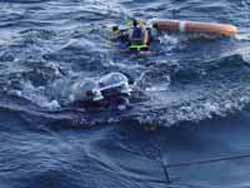AUVfest 2008: Navy Mine-Hunting Robots help NOAA Explore Sunken History
 AUVfest 2008 is a unique opportunity to demonstrate and test the applications of autonomous underwater vehicles, or AUVs, for both mine countermeasures and archaeological research. In total, 13 AUV systems are participating in the missions, which will take place in Rhode Island's Narragansett Bay. AUVfest 2008 is hosted by and based at The Naval Undersea Warfare Center in Newport, Rhode Island. The Office of Naval Research and NOAA's Office of Ocean Exploration and Research are both sponsoring the event.
AUVfest 2008 is a unique opportunity to demonstrate and test the applications of autonomous underwater vehicles, or AUVs, for both mine countermeasures and archaeological research. In total, 13 AUV systems are participating in the missions, which will take place in Rhode Island's Narragansett Bay. AUVfest 2008 is hosted by and based at The Naval Undersea Warfare Center in Newport, Rhode Island. The Office of Naval Research and NOAA's Office of Ocean Exploration and Research are both sponsoring the event.
AUVs are unmanned, underwater robots akin to the Exploration Rover NASA uses on Mars. AUVs operate independent of humans, using their sensors to create maps of the ocean floor, record environmental information, and sense what humans have left behind. In military applications, such as hunting for underwater mines, AUVs can literally save lives. Since World War II, more U.S. Navy ships have been damaged or lost due to mines than all other causes combined. The Office of Naval Research supports and develops AUVs that can locate, classify, and neutralize underwater mines.
Perhaps surprisingly, the AUVs and sensors developed for mine countermeasures can be very useful to maritime archaeologists. Acoustic sonars, for instance, can scan broad areas of the bottom and provide fine-detail images of objects. Below-bottom imaging systems can generate tomographic, or sectional, images of buried objects. As interest grows in deep-water exploration, AUVs can play an important role in discovering clues about human history. One of the goals of AUVfest 2008 is to expose maritime archaeologists to the capabilities of AUVs and sensors in finding, mapping, and protecting shipwrecks and archaeological sites.
Through this collaboration, both federal organizations will benefit. NOAA archaeologists will test existing equipment, allowing them to try AUVs in real archaeological expeditions. Technology developers for the Navy will learn about the needs of a new set of users, driving them to create more flexible and robust systems. Considering both scientific and military objectives can drive new innovations and applications. The Navy and NOAA hope that their partnership will run deep, sustaining and strengthening in the future.
 Deep Sea Crabs
Deep Sea Crabs